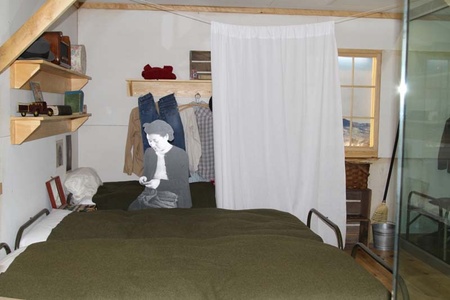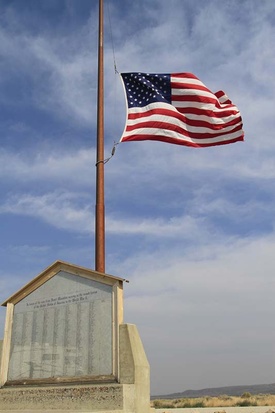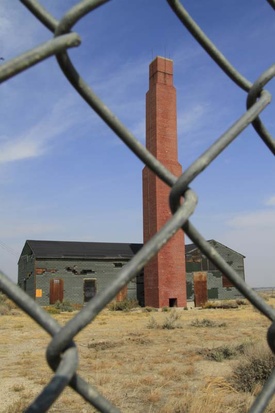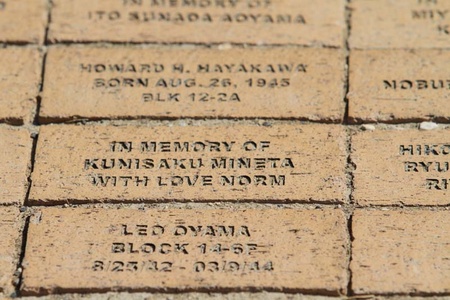No person shall be deprived of life, liberty,
or property without due process of law.
—5th Amendment of the United States Constitution.
What would it be like to have your government move you to a strange place and lock your entire family behind a wire fence? That’s the question the two-year-old Heart Mountain Interpretive Center explores.
Located on a lonely, windswept plain about 15 minutes from Cody, Wyoming, Heart Mountain was one of several “relocation centers” the U.S. government established during World War II where Japanese residents, many of them born in this country and U.S. citizens, were held in the “interest of national security.” After the Japanese attack on Pearl Harbor, the government feared anyone of Japanese descent—regardless of how long they had lived in America—might have allegiance to Japan and pose a threat. Over a four-year period, 120,000 Japanese Americans’ lives were completely disrupted when they were forced to live in barren accommodations in places like Heart Mountain.
As we approach the low-slung building built to echo the minimalist barracks of the camp, the front walkway is embedded with bricks memorializing some of the internees—“In memory of R.S and C. Hifumin,” “Internee Alan ‘Chico’ Kumamoto,” “Bill Haruo Hayakawa Block 12-8-E & F.”
Even before World War II, life in the United States wasn’t easy for Japanese people. By law, Japanese immigrants weren’t allowed to become citizens and newspapers often published anti-Japanese stories and editorials. A 1905 headline in the San Francisco Chroniclewarned, “Japs Bring Frightful Disease.” Before being elected president, Franklin Delano Roosevelt (FDR) had written anti-Japanese editorials. So when Japan attacked Pearl Harbor in 1942, it wasn’t surprising that he willingly signed Executive Order 9066 requiring the forcible removable and incarceration of all people of Japanese origin.
Just What They Could Carry
We crowd into a small theater to watch “All We Could Carry,” a documentary by Japanese filmmaker Steven Okazaki about the relocation. In interviews and old photographs, the film recaps how Japanese people in America, two-thirds of whom were U.S. citizens, were notified that they must leave their jobs and homes, shutter their businesses, and come “with just what they could carry” for relocation.
These people were understandably confused. They didn’t know what relocation meant, but they complied. Many of them put brave faces on the situation for their children. But when they arrived at places like Heart Mountain, the stark reality hit home. “Guards were watching you,” said a woman in the film. “Spotlights followed you at night. I saw the barbed wire and thought ‘My god, this is a concentration camp.’”
More than 14,000 people (about 10,000 at any one time) were incarcerated in 450 bare bones barracks spread over 750 acres at Heart Mountain. Whole families—often six to eight people—were confined to two rooms. Single rooms measured 20×24 feet. Communal bathroom facilities were located some distance away from the living quarters, a burden especially for older people during snowy winters. And there was little privacy, even for the most private activities. One woman internee said, “I went to the bathroom sitting next to strangers.”
The hastily-constructed buildings were built with green lumber covered with lath and plaster. The green wood shrunk as it cured, leaving half inch cracks between the boards that allowed in the frigid Wyoming air. The rooms were heated with small, coal-fired stoves. Insulation, which the internees had to install themselves, didn’t arrive until months into the first bitter Wyoming winter.

The barracks and other buildings at Heart Mountain were hastily built and poorly equipped to keep out the Wyoming cold. (Photo by Anne Weaver)
After the film, we quietly file into the exhibition halls. Each has photos, artifacts, and stories and quotes from detainees. There are pictures of people carrying suitcases and satchels being shuttled onto long trains. One can’t help but think of the forced relocation of Jews by the Nazis. Detainees weren’t allowed to take their pets with them. One man tells about his dog that he left with neighbors. “The dog wouldn’t eat and he starved to death.”
Conditions at Heart Mountain and other camps were harsh. One woman recalled meals of rice and canned tomatoes. “We didn’t complain,” she said. “We made it a positive experience. We endured.”
That resilient spirit is evident in how the Japanese people turned Heart Mountain Relocation Camp into a virtual city. They started a newspaper, elementary and high schools, and, to supplement their meager government-issued food rations, they began farming. They cultivated 1,800 acres and turned what had been unproductive sage brush into lush gardens. They also raised hogs and poultry. Surplus food produced at Heart Mountain was shipped to other internment camps.
Moving through the museum, my heart feels heavy. Like me, fellow visitors are silent; as if speaking would desecrate the memory of what happened to these people.
The exhibits describe the poignant stories with aching detail. It has taken volunteers, both Japanese and Caucasian, 14 years of planning and private fundraising to create this monument. One exhibit tells about a Caucasian woman who chose to stay at Heart Mountain with her Japanese husband. An artist, she made sketches of everyday camp life that capture the bleak reality.
A room in the museum has been transformed into a barracks lit by a single bulb and furnished with chairs and tables residents made from cast off wood and blankets hung for some semblance of privacy. It’s unimaginable that seven or eight people, often adults and children, lived in this small space.

Often eight or more people crowded into a small space with little privacy. The enlarged, photo cutouts look like ghosts from the past. (Photo by Anne Weaver)
War Ends, Heart Ache Continues
Even when the war was over, detainees at Heart Mountain weren’t immediately released and, when they finally were, they were given $25 and a bus ticket to anywhere in the United States. For many, there was nowhere to go. Their homes and businesses had been lost; stored possessions stolen or destroyed.
Despite the industry they’d demonstrated in creating a bustling city at Heart Mountain, the third largest in the state, they weren’t welcome to stay in Wyoming. Then Wyoming governor Lester C. Hunt declared, “We do not want a single one of these evacuees to remain in Wyoming.”
The anti-Japanese sentiment was widespread. One internee said after being released, “They spat on me and called me a dirty yellow Jap.”

This plaque lists the Japanese servicemen who fought for the United States in WW II despite their relatives being held behind barbed wire. (Photo by Anne Weaver)
In the six months following the close of camps like Heart Mountain, there were 30 documented attacks on Japanese citizens on the West coast, including homes torched. Much more violence went undocumented.
Outside the museum, I gulp in the fresh air, but the relief I feel doesn’t last long. Down a concrete walkway, they’ve built a guard tower surrounded by high wire fence. It’s a reminder that this wasn’t a relocation camp; it was a prison.
We drive up the hill and spot the plug of mountain on the horizon that gave the camp its name. At the crest of the hill, there’s an American flag and a scroll of marble, a memorial to the Japanese internees who served in the Armed Forces during World War II. Despite being incarcerated, many young Japanese men received induction orders. Others volunteered. All told, more than 750 served in the military.
The flag is flying at half staff and, for a moment, I wonder why. Then I remember the date: it’s 9/11, yet another date where we’ve allowed fear to make us hate others.
I wander down a winding path with kiosks that point out various places in the camp—the hospital, the administrative building, the swimming hole. Now most of it is farm fields.

The smokestack from Heart Mountain’s hospital boiler stands like a beacon to the cruelty that was the internment camp. (Photo by Anne Weaver)
Just across the way, there’s a lonely gathering of the few remaining original buildings. Walking amidst the barracks and peering through windows into the dusty gloom, it’s hard to imagine hundreds of people living here. To the east, a tall orange chimney, the remnants of the hospital boiler room, stands as an ugly testament to the conditions people endured. Both Japanese and Caucasians worked at the hospital. Caucasian nurses were paid $150/month; Japanese internee nurses $12/month. During the four years Heart Mountain operated, 15 people died and 566 babies were born at the hospital. They were born American citizens behind barbed wire constructed by their own government.
The silence here is deafening. Only the wind disturbs the quiet. Something glitters in the sunlight and I pick it up. It’s a piece of green glass, perhaps from an old pop bottle, its broken edges worn smooth by constant blowing wind and sand. I rub the glass between my fingers and wonder if the person who last touched this glass still lives. Perhaps not. But his or her ghost lives on here at Heart Mountain.
* This article was originally published on Realfoodtraveler.com in November 2013.
© 2013 Bobbie Hasselbring




